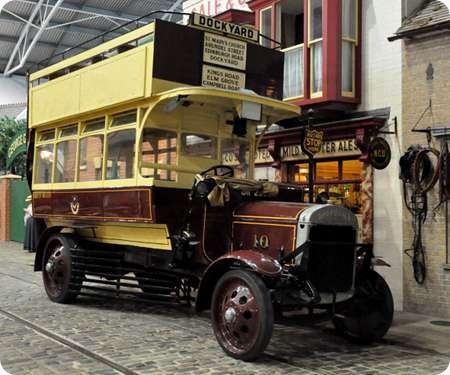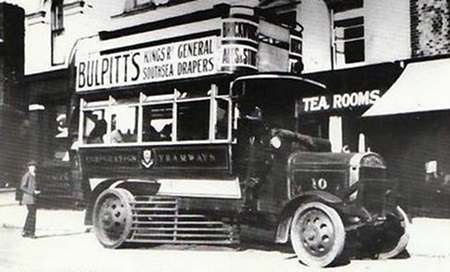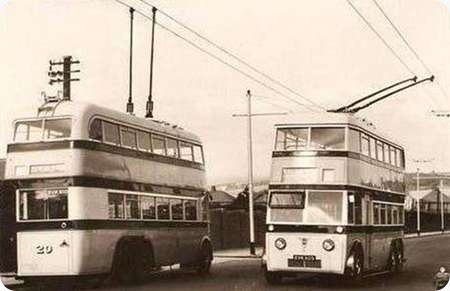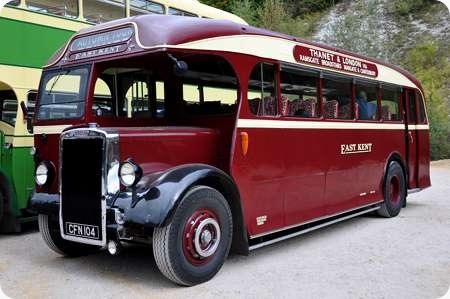Portsmouth Corporation – Thornycroft J – BK 2986 – 10
Portsmouth Corporation
1919
Thornycroft J
Dodson O16/18RO
BK 2986 is a Thornycroft J, built in 1919 for Portsmouth Corporation. It originally had a Wadham O16/18RO seater body but was rebodied in 1926 with an ex London General AEC B 1920 Dodson O16/18RO body. Having been built in Basingstoke, it is fitting that she is seen in the Milestones museum there, one of three Portsmouth buses. Note the tram tracks – there’s a Portsmouth tram there as well. The photograph was take on 12th November 2013.
Photograph and Copy contributed by Pete Davies
07/07/14 – 15:54
Thanks for posting this elderly bus in it’s current position. We are fortunate that Portsmouth Corporation had what we would now call an enlightened view of bus preservation. Both this bus, from it’s first ever batch of buses, and a tram (No 84) were retained by the Corporation from the 1930’s onwards. They also saved the very first trolleybus (201) in 1958, which then went to Beaulieu in 1960. It has had a more chequered history since, but has also resided at Basingstoke for a few years. It is now safe with the CPPTD (the preservation group, not the Corporation!) in Hampshire. The Thornycroft in the picture was quite often brought out and driven around on special occasions for some years. At that time it was in the then-current red/white livery. I remember seeing it at the Brighton Coach Rally c.1962, with a bikini-clad young lady hanging on at the back, trying to smile, wave, and keep her balance! In 1976 (I think), it was used by representatives of the Portsmouth Council to open the new M275 motorway into Portsmouth. Fortunately there was no park and ride service then, otherwise there might have been some suggestions for use? – no, probably not. Both this Thornycroft and the tram seem to be well cared for now, and located in a sympathetic setting at Basingstoke.
Michael Hampton
07/07/14 – 16:39
Am I not right in thinking that this bus was originally No. 10, but renumbered 1 for most of its preserved life, more recently getting back its correct number? I used to see it a lot (with 201) at the late lamented Dave Chalker’s annual Southsea Spectacular on Southsea Common.
Does anyone have a photo of one of these vehicles with original Wadham body. I had one but can’t find it now – typical! Another survivor is what’s left of the 1931 diesel-engined Crossley Condor (RV720), after being cut down as a service vehicle. After being abandoned on the council tip, it was rescued and is a runner.
Chris Hebbron
08/07/14 – 07:18
When you see vehicles like this, you realise the great strides made in chassis and body design in the 13 years between 1919 and 1932.
Chris Hebbron
08/07/14 – 07:20
Yes, Chris, this bus was originally No. 10 in the fleet, out of the series 1-10 for the batch. I read somewhere in a fleet history that it had also been used as a petrol tanker by the Corporation for a while after withdrawal from passenger service. As the Karrier 6-wheel double-deckers bought in 1927/28 to replace these Thornycroft J’s were very thirsty buses , this probably explains the conversion. Another fleet history does state that the Karriers had to be refuelled during the day to keep them in service. Presumably, after the Karriers were withdrawn in 1935, No 10 was redundant as a tanker, and a Dodson body was re-united with it for preservation. It became No.1 in c.1942 – an odd year for such a decision to be made and carried out (don’t you know there’s a war on?). It remained as No.1 until virtually the end of CPPTD, and it’s correct original No.10 restored, I think in the early 1990’s, but I’m open to correction on that.
Michael Hampton
03/10/14 – 08:39
I finally found the picture of No. 10 with its original body, on The Hard – I’ve only ever seen one other photo of these with Wadham bodies.
Chris Hebbron
05/10/14 – 07:26
There is another photograph of this bus with the original body in the PSV Fleet History PH14 Portsmouth Citybus Ltd.(and its predecessors) Pathfinder UK Ltd. Published February 1997
Andy Hemming
25/08/20 – 06:15
Chris Hebbron’s monochrome picture of this bus, also to be found on LTHL, is from a Pamlin print of which I have a postcard. This dates the image capture to 5 October 1925, though the shot seems to show decidedly bright and sunny weather for autumn.
Roger Cox
26/08/20 – 05:21
A sunny Autumn? Well, that’s Sunny Southsea for you Roger! Thx for the extra information and date.
Chris Hebbron
Quick links to the - Comments Page - Contact Page - Home Page




